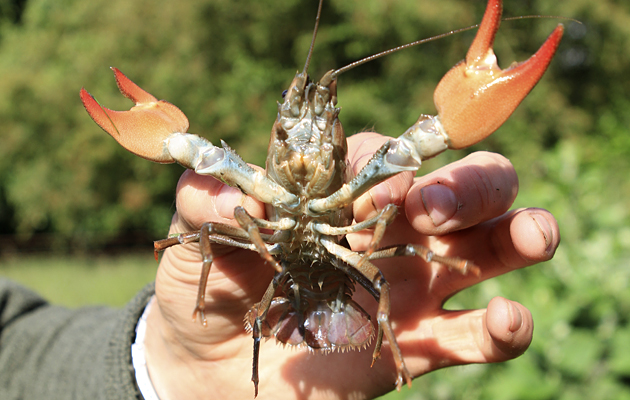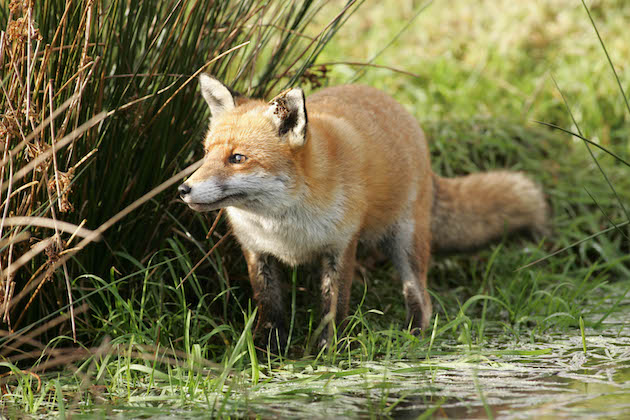John Humphreys gives credit to the otter, which fought its way back from near extinction in the UK
Win CENS ProFlex DX5 earplugs worth £1,149 – enter here
How the American signal crayfish invaded British waters

Man’s stupidity when it comes to moving things around knows no bounds. He decided to bring the North American version of the crayfish to Europe and then to Britain to augment stocks of natives, which were suffering from crayfish plague. Little did the importers know the American signal crayfish were carrying it with them.
The British imports were in the 1970s and little thought was given to the fact that these creatures would happily leave their abode and wander off over the countryside under the cover of darkness like freedom fighters. Like the latter, many succeeded and, from a scattering of sites where they were being kept as potential food, they have colonised much of the country — they have been found as far north as the Moray Firth in Scotland.
Biodiversity risks
It is a sad tale but today we are still not addressing the problems of introducing alien material to our shores. Trees and other plants are being brought in, both in containers and bare rooted, with all the risks that poses. We come home from walking on foreign soil with no checks on the material on our clothing or boots. One of the latest and serious risks to another of our natives is the South American disease Phytophthora austrocedrae, which has affected stands of juniper plants throughout the country.
Try to enter many other countries with contaminated clothing and see what response you get from border control. Your clothing may well be confiscated if it cannot be cleansed.
Declining fisheries
Anglers are known for seeking excuses for fisheries declining, but in the case of their watercourse becoming home to signal crayfish, they have a good reason to be concerned. This little predator knows no limits when it comes to its food supply. It will eat almost anything and research has proved that, without a doubt, its impact is very noticeable when it comes to many native species. Flies, plants, native fish and crayfish, even riverbanks, all come under attack from the signals.
American signal crayfish facts
- It is true that some species of fish will eat the smaller signals but — and it’s a big but — they do not eat enough of them to hold back the tide. At the same time, the signals are eating even more of the fish eggs and fry.
- The female signal crayfish will produce 200 to 400 eggs, which she carries with her under her tail, lobster-like, throughout the winter, until they hatch in the spring.
Once hatched, they go through three moults before they leave their mother. They are advised to leave quickly, as the species is known for cannibalism — she may even eat her own offspring. - The adults are a blue to red-brown colour with a light patch at the hinge of the quite impressive claws. It is this pale patch that gives the crayfish its name because it is not unlike a signal flag when the creature raises its claws.
- Normal size is around 2½in to 3in long, but they can attain 8in and can live well into their teens.
View this post on Instagram
Help from otters
The recolonisation of many river systems by the otter will help a little with control as the otter loves the little morsels. The remains of the bodies can be found on stones and grass banks where the otter has had dinner, with telltale tooth holes in the larger skulls an indication of what consumed it.
How to keep predators out of your pheasant pen
Wise keepers make life as difficult as possible for those pheasant pen predators intent on finding a tasty meal. Birds…
From small introductions, this pest — for that is what the American signal crayfish is on these shores — has spread across 25 European counties, wreaking havoc wherever it has gone. It would appear that its work is not done here, given the impact it has already had on countless native species.
Related Articles
Get the latest news delivered direct to your door
Subscribe to Shooting Times & Country
Discover the ultimate companion for field sports enthusiasts with Shooting Times & Country Magazine, the UK’s leading weekly publication that has been at the forefront of shooting culture since 1882. Subscribers gain access to expert tips, comprehensive gear reviews, seasonal advice and a vibrant community of like-minded shooters.
Save on shop price when you subscribe with weekly issues featuring in-depth articles on gundog training, exclusive member offers and access to the digital back issue library. A Shooting Times & Country subscription is more than a magazine, don’t just read about the countryside; immerse yourself in its most authoritative and engaging publication.









